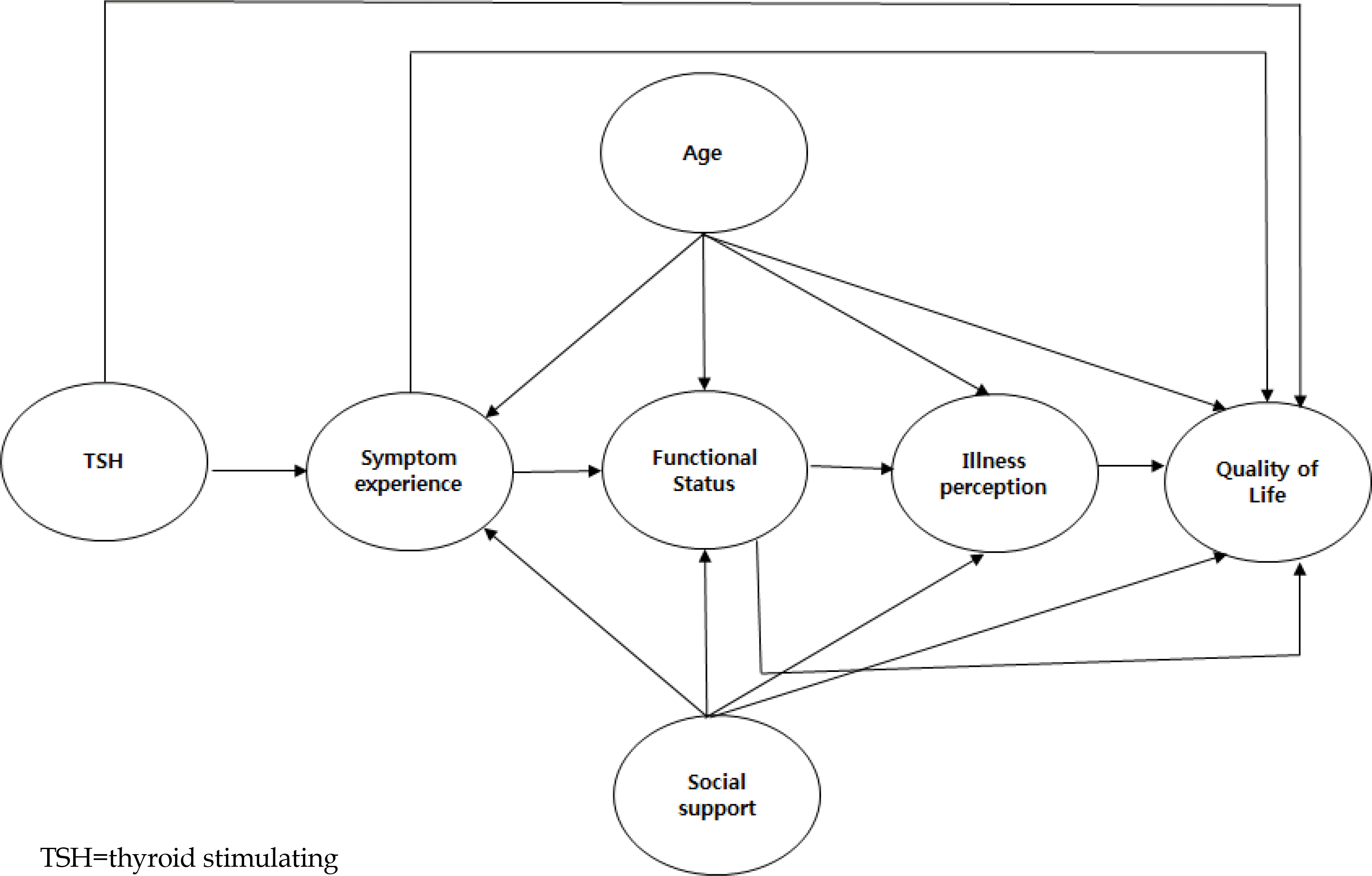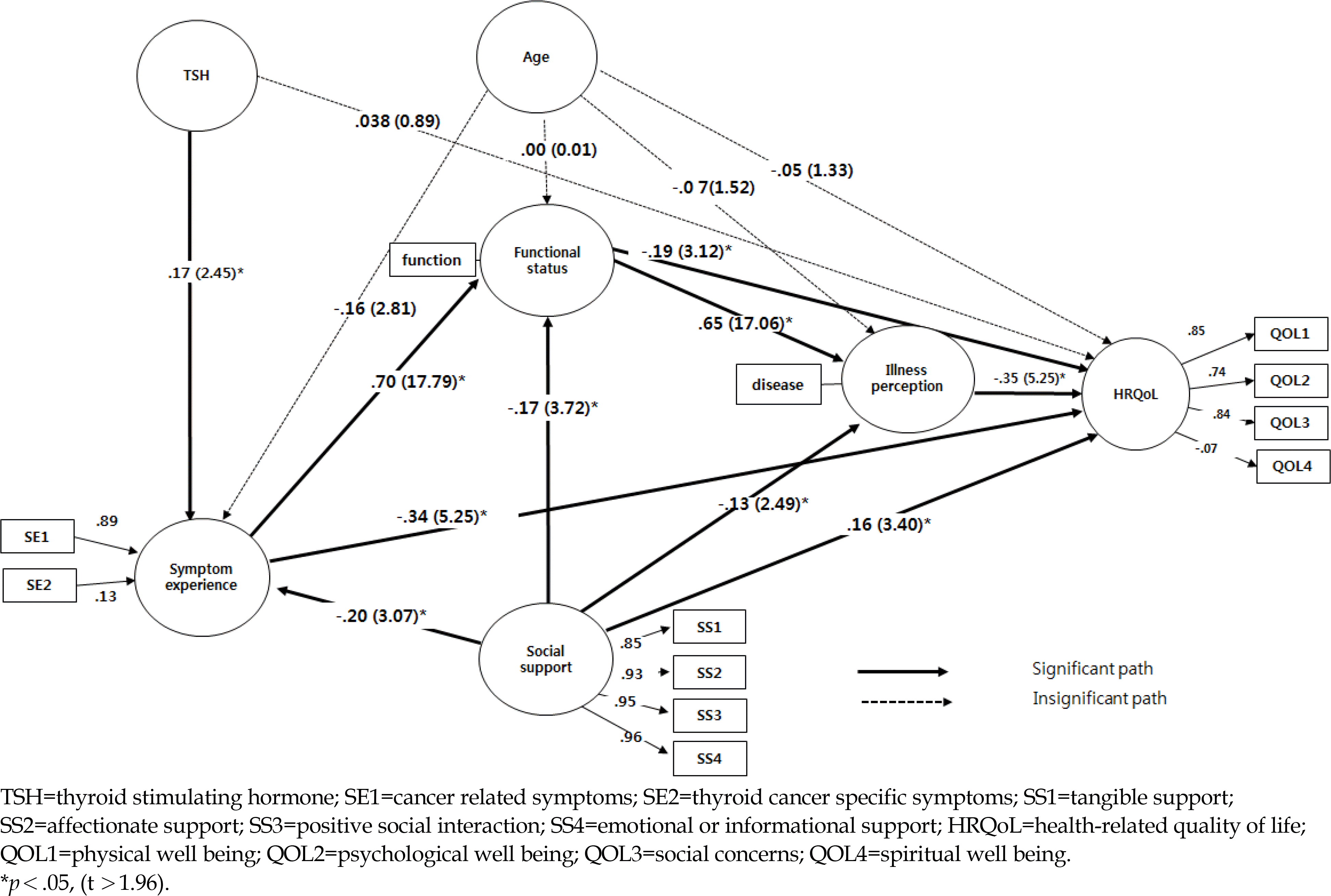Abstract
Purpose
The aim of the study was to create a structural model based on Wilson and Cleary's Conceptual Model of Patient Outcomes. Secondly, the intention was to identify variables influencing the health-related quality of life (HRQoL) as reported by patients with thyroid cancer.
Methods
A total of 201 patients with thyroid cancer were recruited from an outpatient clinic. Data were collected from June to November, 2015, using a structured questionnaire. The questionnaire included the Quality of Life-Thyroid Scale, Thyroid Stimulating Hormone(TSH), Medical Outcome Study Social Support Survey, MD Anderson Symptom Inventory-Thyroid, the Brief Illness Perception Questionnaire, and general characteristics of patients. The data were analyzed using the SPSS/WIN 21.0, AMOS 21.0, and SmartPLS 3.2.3 programs.
Results
The fitness of the hypothetical model with the Wilson and Cleary model was satisfactory, showing that the coefficients of determination(R2) were between .101 and .692 and the predictive relevance(Q2) were between .124 and .320. The model explained 69.2% of the HRQoL. Symptom experience, functional status, disease perception, and social support directly and indirectly affected HRQoL. Age and TSH had an indirect influence on the HRQoL with the mediation effect of reported symptom experience.
Conclusion
To improve the quality of life for patients with thyroid cancer, comprehensive nursing interventions need to be developed and applied. Decreasing the reported symptoms, changing the perception of the disease, improving functional status, and increasing social support may contribute to a higher quality of life among patients with thyroid cancer.
Go to : 
REFERENCES
1. Yoon HJ, Seok JH. Clinical factors associated with quality of life in patients with thyroid cancer. Journal of Korean Thyroid Association. 2014; 7(1):62–9. https://doi.org/10.11106/jkta.2014.7.1.62.

2. Ministry of Health and Welfare/Korea Central Cancer Registry. A press release on cancer statistics in 2015 [Internet]. Seoul: Ministry of Health and Welfare/Korea Central Cancer Registry;2017. [cited 2017 December 23] Available from:. https://ncc.re.kr/cancerStatsView.ncc?bbsnum=418&searchKey=total&searchValue=&pageNum=1https://ncc.re.kr/cancerStatsView.ncc?bbsnum=418&searchKey=total&searchValue=&pageNum=1.
3. Yi KH, Park YJ, Koong SS, Kim JH, Na DG, Ryu JS, et al. Revis-ed Korean thyroid association management guidelines for patients with thyroid nodules and thyroid cancer. Endocrinology and Metabolism. 2010; 25(4):270–97. https://doi.org/10.3803/EnM.2010.25.4.270.

4. Yoo SH, Choi-Kwon S. Changes in quality of life and related factors in thyroid cancer patients with radioactive iodine remnant ablation. Journal of Korean Academy of Nursing. 2013; 43(6):801–11. https://doi.org/10.4040/jkan.2013.43.6.801.

5. Husson O, Haak HR, Oranje WA, Mols F, Reemst PH, van de Poll-Franse LV. Health-related quality of life among thyroid cancer survivors: a systematic review. Clinical Endocrinology. 2011; 75(4):544–54. https://doi.org/10.1111/j.1365-2265.2011.04114.x.

6. Kim JS. Postoperative quality of life in patients with papillary thyroid cancer. Journal of the Korea Academia-Industrial Cooperation Society. 2011; 12(3):1260–9. https://doi.org/10.5762/KAIS.2011.12.3.1260.

7. Lee JI, Kim SH, Tan AH, Kim HK, Jang HW, Hur KY, et al. Decreased health-related quality of life in disease-free survivors of differentiated thyroid cancer in Korea. Health and Quality of Life Outcomes. 2010; 8:101. https://doi.org/10.1186/1477-7525-8-101.

8. Taïeb D, Sebag F, Cherenko M, Baumstarck-Barrau K. Forta-nier C, Farman-Ara B, et al. Quality of life changes and clinical outcomes in thyroid cancer patients undergoing radioiodine remnant ablation (RRA) with recombinant human TSH (rhTSH): a randomized controlled study. Clinical Endocrinology. 2009; 71(1):115–23. https://doi.org/10.1111/j.1365-2265.2008.03424.x.
9. Schultz PN, Beck ML, Stava C, Vassilopoulou-Sellin R. Health profiles in 5836 longterm cancer survivors. International Journal of Cancer. 2003; 104(4):488–95. https://doi.org/10.1002/ijc.10981.

10. Vassilopoulou-Sellin R. Low-risk papillary thyroid cancer: treatment options and patient perceptions. Oncology. 2009; 23(7):589–92.
11. Wilson IB, Cleary PD. Linking clinical variables with health-related quality of life. A conceptual model of patient outcomes. Journal of the American Medical Association. 1995; 273(1):59–65. https://doi.org/10.1001/jama.1995.03520250075037.

12. Wang TS, Cheung K, Mehta P, Roman SA, Walker HD, Sosa JA. To stimulate or withdrawal? A cost-utility analysis of recombinant human thyrotropin versus thyroxine withdrawal for radioiodine ablation in patients with low-risk differentiated thyroid cancer in the United States. The Journal of Clinical Endocrinology & Metabolism. 2010; 95(4):1672–80. https://doi.org/10.1210/jc.2009-1803.
13. Kita T, Yokoyama K, Higuchi T, Kinuya S, Taki J, Nakajima K. Multifactorial analysis on the short-term side effects occurring within 96 hours after radioiodine-131 therapy for differentiated thyroid carcinoma. Annals of Nuclear Medicine. 2004; 18(4):345–9. https://doi.org/10.1007/BF02984474.
14. Rubic M, Kuna SK, Tesic V, Samardzic T, Despot M, Huic D. The most common factors influencing on quality of life of thyroid cancer patients after thyroid hormone withdrawal. Psy-chiatria Danubina. 2014; 26(Suppl. 3):520–7.
15. An JY, An K, O'Connor L, Wexler S. Life satisfaction, self-es-teem, and perceived health status among elder Korean women: focus on living arrangements. Journal of Transcultural Nursing. 2008; 19(2):151–60. https://doi.org/10.1177/1043659607313070.

16. Hirsch D, Ginat M, Levy S, Benbassat C, Weinstein R, Tsvetov G, et al. Illness perception in patients with differentiated epithelial cell thyroid cancer. Thyroid. 2009; 19(5):459–65. https://doi.org/10.1089/thy.2008.0360.

17. Kim HS. The difference in symptom severity, symptom inter-ference, depression, fighting spirit, and social support between younger and older patients with cancer. Journal of the Korean Data Analysis Society. 2014; 16(4):2143–59.
18. Kritpracha C. Influences of cognitive representations of breast cancer on emotional responses and coping in Thai women newly diagnosed with breast cancer [dissertation]. Ann Arbor: The University of Michigan;2004.
19. Almeida JP, Vartanian JG, Kowalski LP. Clinical predictors of quality of life in patients with initial differentiated thyroid cancers. Archives of Otolaryngology-Head & Neck Surgery. 2009; 135(4):342–6. https://doi.org/10.1001/archoto.2009.16.

20. Roberts KJ, Lepore SJ, Urken ML. Quality of life after thyroid cancer: an assessment of patient needs and preferences for information and support. Journal of Cancer Education. 2008; 23(3):186–91. https://doi.org/10.1080/08858190802247762.

21. Efficace F, Baccarani M, Breccia M, Cottone F, Alimena G, Deli-liers GL, et al. Chronic fatigue is the most important factor limiting health-related quality of life of chronic myeloid leukemia patients treated with imatinib. Leukemia. 2013; 27(7):1511–9. https://doi.org/10.1038/leu.2013.51.

22. Kim CH. Factors affecting symptom experiences and health- related quality of life in the patients with thyroid cancer [dissertation]. Seoul: Yonsei University;2006.
23. Kim GS. Easy SEM with SmartPLS. Seoul: CheongRam Publishing;2013.
24. Dow KH, Ferrel BR, Anello C. Quality of life changes in patients with thyroid cancer after withdrawal of thyroid hormone therapy. Thyroid. 1997; 7(4):613–9. https://doi.org/10.1089/thy.1997.7.613.
25. Sherbourne CD, Stewart AL. The MOS social support survey. Social Science & Medicine. 1991; 32(6):705–14. https://doi.org/10.1016/0277-9536(91)90150-B.

26. Lim MK. Relationships between social support and health among low income groups in urban area [master's thesis]. Seoul: Seoul National University;2002.
27. Gning I, Trask PC, Mendoza TR, Harle MT, Gutierrez KA, Kitaka SA, et al. Development and initial validation of the thyroid cancer module of the M.D. Anderson Symptom Inventory. Oncology. 2009; 76(1):59–68. https://doi.org/10.1159/000178809.
28. Bae BR. Structural equation modeling with Amos 21: principles and practice. Seoul: CheongRam Publishing;2014.
29. Hair JF, Hult GTM, Ringle CM, Sarstedt M. Primer on partial least squares structural equation modeling (PLS-SEM). 1st ed.Kim JH, Shim KH, Lee CS, translator. Goyang: PNC Media;2014.
30. Broadbent E, Petrie KJ, Main J, Weinman J. The brief illness perception questionnaire. Journal of Psychosomatic Research. 2006; 60(6):631–7. https://doi.org/10.1016/j.jpsychores.2005.10.020.

31. Seong YS, Lee YW. Relationship of illness perception, self-efficacy, and self-care among pulmonary tuberculosis patients. Korean Journal of Adult Nursing. 2011; 23(1):31–9.
32. Huang SM, Lee CH, Chien LY, Liu HE, Tai CJ. Postoperative quality of life among patients with thyroid cancer. Journal of Advanced Nursing. 2004; 47(5):492–9. https://doi.org/10.1111/j.1365-2648.2004.03128.x.

33. Han SS, Shin IS, Kim YJ. Factors that influence quality of life in cancer patients. Korean Journal of Health Promotion. 2009; 9(1):33–40.
34. Kim KO, Kim JA. Influences of uncertainty and social support on the quality of life among elderly cancer patients. Asian Oncology Nursing. 2017; 17(3):180–7. https://doi.org/10.5388/aon.2017.17.3.180.

35. Ahn HJ, Tae YS, Han YI. The relationship between spiritual health and uncertainty in cancer patients having chemotherapy. Journal of Korean Oncology Nursing. 2007; 7:107–18.
Go to : 
Table 1.
Sociodemographic and Clinical Characteristics of Patients (N=201)
Table 2.
Descriptive Statistics and Convergent Validity of Study Variables (N=201)
Table 3.
Analysis of Mediation Effect (N=201)




 PDF
PDF ePub
ePub Citation
Citation Print
Print




 XML Download
XML Download